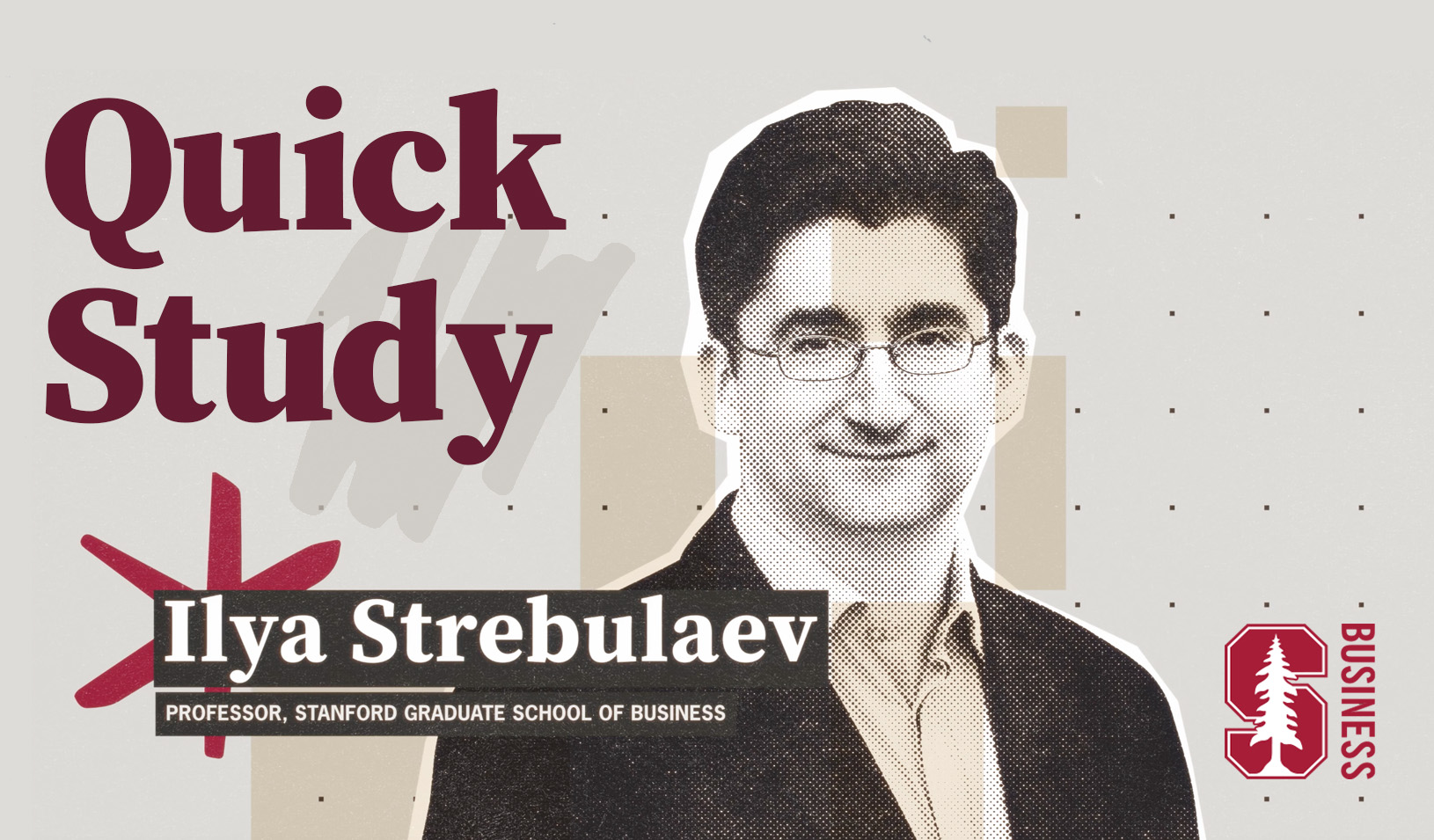Despite the coronavirus pandemic, venture capitalists report that they are as busy as ever and optimistic about the future. | Reuters/Christian Hartmann
In the early weeks of the COVID-19 pandemic, venture capital firms, like most of the U.S. economy, essentially shut down. “A lot of VCs were telling me that everything just froze,” says Ilya A. Strebulaev, professor of finance at Stanford Graduate School of Business and director of the school’s Venture Capital Initiative.
Indeed, an April report by the National Venture Capital Association warned of a looming “capital crunch,” saying that “investment in the startup ecosystem is expected to drop significantly” as investors shy away from these “high-risk and illiquid” companies.
“Fasten your seatbelts,” the authors wrote. “It’s going to be a bumpy ride.”
As it turns out, the ride has been surprisingly smooth. In a newly released survey of more than 1,000 venture capitalists, representing some 900 firms, Strebulaev and his coresearchers found that VCs are as busy as ever. And they are, in fact, remarkably optimistic about the future.
While the pace of new investments did slow to 71% of normal in the first half of 2020, that figure included the initial weeks of paralysis. For the second half, VCs say they expect the pace to be over 80%. That’s a lot better than in the last two recessions. After the dot-com crash of 2000, VC investments fell to 50% of normal; in the Great Recession of 2008 they fell to 70%.
What’s more, respondents say that half of their portfolio companies are either unaffected by the COVID-19 pandemic or are actually benefiting from it. Only 10% of portfolio companies are “severely negatively affected,” they report. Overall, VC funds anticipate only a tiny dip in their financial performance.
All of that, in turn, seems likely to keep the tap open on capital flow, which is great news for entrepreneurs.
A Research Pivot
The survey, which was conducted in June, was originally planned as a follow-up to a similar survey the coauthors did five years ago. That work, which revealed new insights into an industry that likes to work behind the scenes, became the most frequently cited research paper ever on venture capital over the last few years.
“It seemed like time for an update,” Strebulaev says. “Venture capital funds typically have a 10- to 12-year horizon, and the investment period during which funds form their portfolio is about 3 to 5 years, so we wanted to do another survey and see how the industry is doing.” Preparations for the survey were underway at the usual unhurried academic pace when the pandemic hit. “We realized we absolutely must do this right now.”
With help from alumni offices at the Stanford, Harvard, and Chicago business schools, the researchers quickly pulled together contacts and sent out a new questionnaire. The response rate was high, and the surveys came back fast — it seemed that VCs wanted as much as anyone to know what others were seeing and thinking. Instead of months, it took 10 days to complete.
The new survey asked many of the same questions as the first one, to see how the industry had evolved. One interesting development, Strebulaev notes, is that corporate VC divisions, which are a growing segment of the venture capital sector, have become much more like traditional stand-alone VC funds in their operations. “It shows that corporate VC has really grown up,” he says.
Another finding, which should put an even bigger smile on the face of entrepreneurs, is that the contractual terms of VC funding have become more founder-friendly (as opposed to investor-friendly). The researchers looked at a number of deal parameters affecting cash-flow rights, control, and liquidation rights and found this trend to be consistent across the board.
What Capital Crunch?
That’s surprising in the face of a recession and widespread uncertainty. If the predicted capital shortage had materialized — if investors had tightened their purse strings or shifted toward more liquid investments — you’d have expected to see VC deal terms shift in the opposite direction, Strebulaev points out.
“It’s a story of supply and demand, as in any market. Clearly there’s been an increase in demand for startup capital in the past five years. You see it in Silicon Valley; you see it around the world. There are so many disruptive new ideas, new companies. There are innovation hubs that didn’t exist ten, even five years ago. But the supply of funding has grown even more.”
The reason, he thinks, is that more investors are looking to profit from what they see as a time of rapid change and high growth potential. “The number of VC funds has continued to grow, and at the same time, you now have other financing options springing up. At the early stage, there are a lot of active angel investors, crowdfunding platforms, ICOs, and so on. At later stages, private equity funds, sovereign wealth funds, even mutual funds are competing with VCs to bankroll startups.”
The upshot, Strebulaev says, is that for entrepreneurs seeking capital, it’s still a buyer’s market, despite the pandemic.
How VCs Are Spending Their Time
Of course, this is not just about money. The venture capital business model is unique in that VCs remain deeply involved in managing their portfolio companies, working much closer to the ground than other investors. As a result, they really know the businesses and are able to guide founders through the white-knuckle process of building a company.
Strebulaev’s original survey found that VCs worldwide worked 55 hours a week on average. In the new survey, that was up to 58 hours. As before, the single largest use of their time, at one-third, is working with existing portfolio companies — 19.4 hours a week. Now, presumably, that work is done by remote conferencing rather than in-person meetings.
Individual VCs also spend 14.4 hours a week on average sourcing new deals and 6.4 hours networking. These figures are slightly lower than in 2015, and most respondents say it’s harder to find and evaluate new investments during the lockdown. That’s not surprising, since VCs are used to meeting with investment candidates in person.
“It’s a face-to-face business,” Strebulaev says, “You’re evaluating not just a product and a business model but also the people, the management team and leaders. You really want to look them in the eye.”
Nevertheless, the survey’s respondents expect to invest at 81% of their normal pace in the second half of this year, which should alleviate fears that the hands-on style of venture capital investment is unworkable in the coronavirus era.
“Maybe VCs found out that while face-to-face is fantastic, their business model can survive the lockdown,” Strebulaev says. “You can’t sit down with entrepreneurs and look them in the eye, but maybe the Zoom eye is almost as good as real life.”
Why It Matters
That’s good news for everyone, Strebulaev says, because while venture capital is a relatively small industry, it has a huge influence on the long-term health of the economy. “VC firms are in large part responsible for the private innovation that happens in this country,” he says.
Of the thousands of American firms that went public over the past 40 years, 43% of them were venture-backed, Strebulaev notes, including 9 of the top 10 in terms of current market cap.
“VCs were the first institutional investors in Microsoft, Apple, FedEx, Google, Facebook, Uber, Intel, even Starbucks,” Strebulaev says. “Without venture capital, many of these companies would not exist. Companies that bring a truly new product to market have tremendous opportunities but also face tremendous uncertainty. You’re dealing with an unknown product in an unknown market, and startups are statistically likely to fail. No other financial intermediaries are as well positioned to invest in these conditions.”
Compare that to Europe or Japan, where venture capital didn’t emerge until recently, Strebulaev says. “They don’t have a Google or Apple or Intel. So I’d argue that for most of us, venture capital is very important in our everyday life — both in terms of the income and jobs created by economic growth as well as our lifestyle — and most people just don’t realize that it is in a large way due to venture capital’s contribution.”
Reasons for Optimism
Strebulaev says it’s reasonable to hope that the funds’ positive outlook is a bellwether for the economy as a whole. Yes, part of that confidence may reflect the fact that VCs are long-term thinkers. Even in normal times, they don’t expect their portfolio companies to be profitable at first, so a business downturn might not loom as large in their view as for the average investor.
But mainly, Strebulaev says, they’re optimistic because they see plenty of opportunities ahead. The current recession is fundamentally different than, say, the dot-com crash of 2000; in that case, there was a loss of confidence in the very idea of digitizing the economy. The tech sector seemed to have failed, and the term “disruption” became a punch line. That’s no longer the case.
If anything, the opposite is true. The pandemic has abruptly changed how we live, in ways that often require more tech mediation. (Who would have thought video conferencing would become a daily necessity for so many people?) That may be part of the reason why VCs report that half of their portfolio companies are either unaffected by the pandemic or have benefited from it.
And there’s more to come. “I’ve talked to a lot of venture capitalists here in Silicon Valley,” Strebulaev says, “and they all tell me that this may be the best time to be around — there are so many interesting investments right now. People are sitting at home coming up with new entrepreneurial ideas.”
That’s not to say every startup will become a unicorn. When VCs say they expect their funds’ performance to hold steady through the current crisis, those aggregate numbers conceal the fact that there are winners and losers. But it’s always been that way: Most new companies fail, and the VC business model has always relied on throwing dozens of darts in the hope of hitting one or two bull’s-eyes.
For media inquiries, visit the Newsroom.






